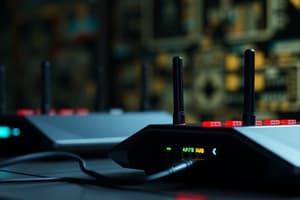Podcast
Questions and Answers
What is the primary aim of a denial of service attack in a wireless network?
What is the primary aim of a denial of service attack in a wireless network?
- To increase the number of connected devices
- To improve network performance
- To enhance data encryption
- To prevent legitimate users from accessing resources (correct)
Which method is used to make a channel appear busy in a Queensland DoS attack?
Which method is used to make a channel appear busy in a Queensland DoS attack?
- Running heavy data transfers
- Increasing encryption levels
- Exploiting CSMA/CA mechanisms (correct)
- Rapidly switching AP connections
What is the effect of an 802.11 Beacon Flood attack?
What is the effect of an 802.11 Beacon Flood attack?
- To increase latency in client connections
- To strengthen the encryption of data traffic
- To facilitate legitimate connections to an AP
- To drown out legitimate access points with counterfeit beacons (correct)
What is the primary purpose of sending invalid TKIP data in 802.11 TKIP MIC Exploit attacks?
What is the primary purpose of sending invalid TKIP data in 802.11 TKIP MIC Exploit attacks?
Which of the following tools is commonly used for man-in-the-middle attacks on an evil twin AP?
Which of the following tools is commonly used for man-in-the-middle attacks on an evil twin AP?
Which attack technique is used to flood a target with EAP-Start messages?
Which attack technique is used to flood a target with EAP-Start messages?
What consequence can arise from executing a 802.1X EAP-of-Death attack?
What consequence can arise from executing a 802.1X EAP-of-Death attack?
What does AP phishing involve?
What does AP phishing involve?
What is a characteristic of WPA/WPA2 key cracking techniques?
What is a characteristic of WPA/WPA2 key cracking techniques?
In authentication attacks, what is the goal of stealing user credentials?
In authentication attacks, what is the goal of stealing user credentials?
Which technique is often used in EAP manipulation to gain unauthorized access?
Which technique is often used in EAP manipulation to gain unauthorized access?
Which method is commonly used for Shared Key Guessing attacks?
Which method is commonly used for Shared Key Guessing attacks?
What is the purpose of Wireless Intrusion Prevention Systems (WIPS)?
What is the purpose of Wireless Intrusion Prevention Systems (WIPS)?
What can Wireless Intrusion Prevention Systems (WIPS) help to prevent?
What can Wireless Intrusion Prevention Systems (WIPS) help to prevent?
Which of the following tools is commonly associated with flooding techniques against an AP?
Which of the following tools is commonly associated with flooding techniques against an AP?
What is a main characteristic of the 802.11 Deauthenticate Flood attack?
What is a main characteristic of the 802.11 Deauthenticate Flood attack?
What tool can be used for WPA/WPA2 PSK recovery through a dictionary attack?
What tool can be used for WPA/WPA2 PSK recovery through a dictionary attack?
Which of the following is primarily used for capturing user application login credentials?
Which of the following is primarily used for capturing user application login credentials?
Which attack technique is intended for guessing passwords in 802.1X authentication processes?
Which attack technique is intended for guessing passwords in 802.1X authentication processes?
What is the purpose of tools like THC-LEAPcracker in relation to LEAP packets?
What is the purpose of tools like THC-LEAPcracker in relation to LEAP packets?
Which method can be employed to capture user identities in a network using 802.1X?
Which method can be employed to capture user identities in a network using 802.1X?
What type of attack is used to recover user credentials from captured NetBIOS password hashes?
What type of attack is used to recover user credentials from captured NetBIOS password hashes?
Which tool is specifically mentioned for executing brute-force attacks on VPN authentication protocols?
Which tool is specifically mentioned for executing brute-force attacks on VPN authentication protocols?
Which of the following is NOT typically a technique used for cracking user credentials?
Which of the following is NOT typically a technique used for cracking user credentials?
Flashcards
PSK Cracking
PSK Cracking
Recovering a WPA/WPA2 Pre-Shared Key (PSK) from captured key handshake frames using a dictionary attack tool.
Application Login Theft
Application Login Theft
Capturing user credentials (e.g., email address and password) from cleartext application protocols to steal user information.
Domain Login Cracking
Domain Login Cracking
Recovering Windows login and password by cracking NetBIOS password hashes using brute-force or dictionary attack tools.
VPN Login Cracking
VPN Login Cracking
Signup and view all the flashcards
802.1X Identity Theft
802.1X Identity Theft
Signup and view all the flashcards
802.1X Password Guessing
802.1X Password Guessing
Signup and view all the flashcards
802.1X LEAP Cracking
802.1X LEAP Cracking
Signup and view all the flashcards
Password Dictionary Attack
Password Dictionary Attack
Signup and view all the flashcards
802.11 Authentication Flood
802.11 Authentication Flood
Signup and view all the flashcards
802.11 Deauthentication Flood
802.11 Deauthentication Flood
Signup and view all the flashcards
802.1X EAP-Start Flood
802.1X EAP-Start Flood
Signup and view all the flashcards
802.1X EAP Failure Attack
802.1X EAP Failure Attack
Signup and view all the flashcards
802.1X EAP-of-Death
802.1X EAP-of-Death
Signup and view all the flashcards
Shared Key Guessing
Shared Key Guessing
Signup and view all the flashcards
802.11 TKIP MIC Exploit
802.11 TKIP MIC Exploit
Signup and view all the flashcards
Authentication Attacks
Authentication Attacks
Signup and view all the flashcards
Evil Twin AP
Evil Twin AP
Signup and view all the flashcards
AP Phishing
AP Phishing
Signup and view all the flashcards
Man in the Middle
Man in the Middle
Signup and view all the flashcards
Availability Attacks
Availability Attacks
Signup and view all the flashcards
AP Theft
AP Theft
Signup and view all the flashcards
Queensland DoS
Queensland DoS
Signup and view all the flashcards
802.11 Beacon Flood
802.11 Beacon Flood
Signup and view all the flashcards
Denial of Service (DoS)
Denial of Service (DoS)
Signup and view all the flashcards
Study Notes
Wireless Network and Network Attacks
- Wireless networks face various security threats
- Examples include: lack of physical security, use of untrusted networks, use of untrusted mobile devices, use of applications created by unknown parties, interaction with other systems, use of untrusted content, and use of location services
- Defense techniques include changing router default username/password and the network IP subnet if possible.
- Changing the service set identifier (SSID) and hiding its broadcasting
- Restricting wireless network access by filtering based on the Media Access Control (MAC) addresses
- Using encryption
Wireless Threats: Access Control Attack
- Aims to penetrate a network by evading WLAN access control measures like AP MAC filters and Wi-Fi port access control.
Types of Access Control Attacks
- War Driving: Discovering wireless LANs by listening to beacons or sending probe requests, enabling further attack opportunities
- Rogue Access Points: Placing an unsecured access point inside a firewall, creating a backdoor into a trusted network.
- Ad Hoc Associations: Connecting directly to an unsecured station to circumvent security measures or for attacks.
- MAC Spoofing: Reconfiguring an attacker's MAC address to appear as an authorized access point or station.
- 802.1X RADIUS Cracking: Recovering RADIUS secret by brute force from 802.1X access requests for use by evil twin APs
Wireless Threats: Integrity Attacks
- Attackers send forged control, management, or data frames over a wireless network to misdirect the wireless device, enabling further attacks
- 802.11 Frame Injection: Crafting and sending forged 802.11 frames
- 802.11 Data Replay: Capturing 802.11 data frames for later (modified) replay.
- 802.1X EAP Replay: Capturing Extensible Authentication Protocol (EAP) messages (e.g., identity, success, failure) for later replay
- 802.1X RADIUS Replay: Capturing RADIUS Access-Accept or Reject messages for later replay
Wireless Threats: Confidentiality Attacks
- Attacks aim to intercept sensitive information sent over wireless associations, regardless of clear text or encryption used in Wi-Fi protocols
- Eavesdropping: Capturing and decoding unprotected application traffic to obtain sensitive information
- WEP Key Cracking: Capturing data to recover the WEP key using passive or active methods
- Evil Twin AP: Masquerading as an authorized access point (AP) to lure users
- AP Phishing: Creating a fake web portal on an evil twin AP to trick users into entering sensitive information
- Man-in-the-Middle: Running traditional man-in-the-middle attack tools on an evil twin AP to intercept TCP sessions or SSL/SSH tunnels.
Wireless Threats: Availability Attacks
- Denial of service (DoS) attacks aim to prevent legitimate users from accessing network resources
- AP Theft: Physically removing an access point from a public area
- Queensland DoS: Exploiting the CSMA/CA mechanism to make a channel appear busy
- 802.11 Beacon Flood: Generating many counterfeit 802.11 beacons to make it hard for stations to find a legitimate AP
- 802.11 Associate/Authenticate Flood: Sending forged Authenticates or Associates from random MACs to fill a target AP's association table
Other Attacks
- Misconfigured Access Point Attack: Vulnerabilities in access point configuration can allow for exploitation
- Unauthorized Association: Establishing connections to a network without authorization
- HoneySpot Access Point attack: Using a decoy access point to trap attackers
- AP MAC Spoofing: Using a forged MAC address to impersonate a legitimate access point
- Denial of Service (DoS) attack: Attempts to disrupt the network's functionality by overwhelming it
- Jamming Signal attack: Disrupting communication by flooding the environment with radio waves
Wireless Threats: Authentication Attacks
- Stealing the identity of a Wi-Fi client through personal information or login credentials to gain unauthorized access to network resources
- Shared Key Guessing: Attempting 802.11 shared key authentication with guessed, default, or cracked WEP keys
- PSK Cracking: Recovering WPA/WPA2 PSK from captured key handshake frames using a dictionary attack
- Application Login Theft: Capturing user credentials from clear-text application protocols
- Domain Login Cracking: Recovering user credentials by cracking NetBIOS password hashes
- VPN Login Cracking: Recovering PPTP or IPsec credentials by brute force
- 802.1X Identity Theft: Capturing user identities from cleartext 802.1X Identity Response packets
- 802.1X Password Guessing: Repeatedly attempting 802.1X authentication to guess a user's password
- 802.1X LEAP Cracking: Recovering user credentials from captured 802.1X Lightweight EAP (LEAP) packets using a dictionary attack on the NT password hash
Rogue Access Point Attack
- Placing a rogue access point in an 802.11 network can hijack the connection of legitimate network users
- When a user turns on their computer, a rogue access point might offer a connection
- All traffic will pass through the rogue access point, enabling packet sniffing
Client Mis-association
- Attackers set up a rogue access point outside the corporate perimeter to lure employees into connecting
- Once connected, employees potentially bypass enterprise security policies.
Studying That Suits You
Use AI to generate personalized quizzes and flashcards to suit your learning preferences.




